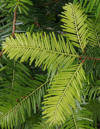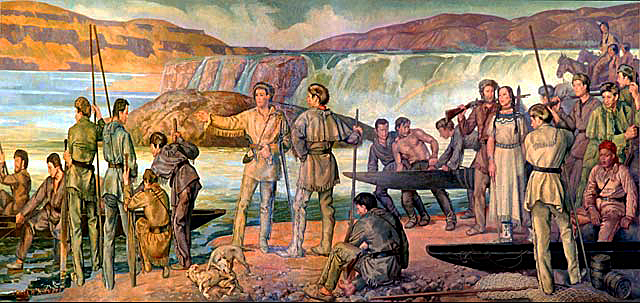|
Celebrating The Corps of Discovery
Expedition Bicentennial
Originally Published February 21, 2003 |
|
|
Botanical Discoveries:
Grand Fir (Abies grandis)
Fort Clatsop, Oregon, February 6, 1806
Stately and beautiful, the
Grand Fir (Abies grandis) is every bit a grand species, prized
in modern times for its use as an ornamental and timber tree. It is found
most commonly at low elevations on North-facing slopes, and indicates and
often dominates moist habitats. Accustomed to the deciduous trees of the
eastern seaboard, Captain Lewis was doubtless enthralled by this large,
lushly foliaged specimen. Nowadays, the Grand Fir has gained popularity as
a Christmas Tree. Click on thumbnail for large view.
|
 |
|
|
 |
|
The Expedition's Journey
Continues:
The expedition's winter layover at Fort Clatsop continued to be brightened
by visiting dignitaries from other nations, giving the voyagers more
knowledge of this new land and it's inhabitants. Captain Lewis records in
his journal on February 20, 1806:
This forenoon we were visited by Tabcum, a
principal chief of the Chinooks, and 25 men of his nation. We had never
seen this chief before. He is a good-looking man about 50 years of age,
rather larger in stature than most of his nation. As he came on a
friendly visit, we gave himself and party something to eat and plied
them plentifully with smoke. We gave this chief a small medal, with
which he seemed much gratified.
In the evening at sunset we desired them to
depart, as is our custom, and closed our gates. We never suffer parties
of such number to remain within the fort all night; for, notwithstanding
their apparent friendly disposition, their great avarice and hope of
plunder might induce them to be treacherous. At all events, we
determined always to be on our guard as much as the nature of our
situation will permit us, and never place ourselves at the mercy of any
savages. We well know that the treachery of the aborigines of America
and the too great confidence of our countrymen in their sincerity and
friendship has caused the destruction of many hundreds of us.
No matter how many guests the Corps and the Captains entertained, they
did not lose sight of their other missions of mapping the terrain and
gathering details of the flora and fauna.
Go to our Corps of Discovery Expedition
Bicentennial Index page
to see all links in this series. Or click
here
to go directly to the next installment of our
journey.
|
|
 |
|
Bringing history
alive: |
|
 |
This mural by Frank H. Schwarz in 1837, depicts Lewis
and Clark, Sacajawea and members of the Corps of Discovery at Celilo
Falls during their journey to the Pacific. It hangs in the Oregon
Capitol rotunda. It was the centerpiece of a display at the capitol
presented by the Oregon Historical Society in 2004. |
"Picturing
the Corps of Discovery demonstrates how artistic interpretations of the
Lewis and Clark Expedition mirror the history and evolving values of
Americans, and more specifically Oregonians, over the past two centuries.
Viewers will be introduced to works of art with Lewis-and-Clark themes
that reflect changing understandings of topics as diverse as democratic
ideals, ethnicity, and the environment.
A
collection of images of Lewis and Clark pointing westward, including Frank
Schwarz's treasured 1938 mural in Oregon's Capitol rotunda, demonstrate
how the two explorers were credited with introducing civilization to the
West well into the first half of the twentieth century. By the end of the
century, however, works like Michael Florin Dente's 1988 sculpture, The
Naming of Mount Jefferson, at the University of Portland, celebrated the
expedition's ethnic mix as a historical precedent for a multicultural,
pluralistic society in the West."
|